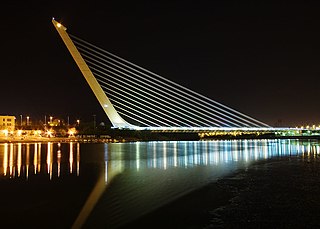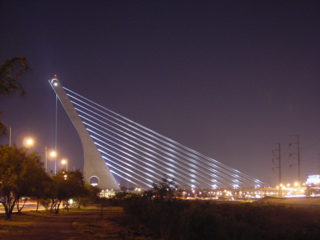
Santiago Calatrava Valls is a Spanish architect, structural engineer, sculptor and painter, particularly known for his bridges supported by single leaning pylons, and his railway stations, stadiums, and museums, whose sculptural forms often resemble living organisms. His best-known works include the Olympic Sports Complex of Athens, the Milwaukee Art Museum, the Turning Torso tower in Malmö, Sweden, the World Trade Center Transportation Hub in New York City, the Auditorio de Tenerife in Santa Cruz de Tenerife, the Margaret Hunt Hill Bridge in Dallas, Texas, and his largest project, the City of Arts and Sciences and Opera House in his birthplace, Valencia. His architectural firm has offices in New York City, Doha, and Zürich.
The year 2001 in architecture involved some significant architectural events and new buildings.

The Sundial Bridge is a cantilever spar cable-stayed bridge for bicycles and pedestrians that spans the Sacramento River in Redding, California, United States and forms a large sundial. It was designed by Santiago Calatrava and completed in 2004 at a cost of US$23.5 million. The bridge has become iconic for Redding.

The Alamillo Bridge is a structure in Seville, Andalucia (Spain), which spans the Canal de Alfonso XIII, allowing access to La Cartuja, a peninsula located between the canal and the Guadalquivir River. The bridge was constructed as part of infrastructure improvements for Expo 92, which was held on large banana farms on the island. Construction of the bridge began in 1989 and was completed in 1992 from a design by Santiago Calatrava.

A cantilever spar cable-stayed bridge is a modern variation of the cable-stayed bridge. This design has been pioneered by the structural engineer Santiago Calatrava in 1992 with the Puente del Alamillo in Seville, Spain. In two of his designs the force distribution does not depend solely upon the cantilever action of the spar (pylon); the angle of the spar away from the bridge and the weight distribution in the spar serve to reduce the overturning forces applied to the footing of the spar. In contrast, in his swinging Puente de la Mujer design (2002), the spar reaches toward the cable supported deck and is counterbalanced by a structural tail. In the Assut de l'Or Bridge (2008), the curved backward pylon is back-stayed to concrete counterweights.

The Zubizuri, also called the Campo Volantin Bridge or Puente del Campo Volantin, is a tied arch footbridge across the Nervion River in Bilbao, Spain. Designed by architect Santiago Calatrava, the bridge links the Campo Volantin right bank and Uribitarte left bank of the river.

Puerto Madero, also known within the urban planning community as the Puerto Madero Waterfront, is a barrio of Buenos Aires in the Central Business District. Occupying a significant portion of the Río de la Plata riverbank, it is the site for several high-rise buildings and luxurious hotels, featuring the latest architectural trends.
Women's Bridge or Woman's Bridge may refer to:

Puente de la Unidad or Viaducto de la Unidad is a cantilever spar cable-stayed bridge designed by Óscar Bulnes that crosses the Santa Catarina River and connects the cities of Monterrey and San Pedro Garza García in the Mexican state of Nuevo León. It is part of a circuit called "Circuito La Unidad", which would consist of the interconnection of a series of avenues.
Puente, a word meaning bridge in Spanish language, may refer to:

The Chords Bridge, also called the Bridge of Strings or Jerusalem Light Rail Bridge, is a side-spar cable-stayed bridge in Jerusalem. The structure was designed by the Spanish architect and engineer Santiago Calatrava and is used by Jerusalem Light Rail's Red Line, which began service on August 19, 2011. Incorporated in the bridge is a glass-sided pedestrian bridge enabling pedestrians to cross from Kiryat Moshe to the Jerusalem Central Bus Station. The bridge, which cost about $70 million, was inaugurated on June 25, 2008.

The Tranvía del Este, also known as the Puerto Madero Tramway, was a 12-block "demonstration" light rail line in the Puerto Madero neighborhood of Buenos Aires, Argentina, in operation from 2007 to 2012. It used French-built Alstom Citadis 302 trams on loan, initially from Mulhouse, France, and later from Madrid, Spain, and was operated by the rail company Ferrovías.

Samuel Beckett Bridge is a cable-stayed swingbridge in Dublin, Ireland that joins Sir John Rogerson's Quay on the south side of the River Liffey to Guild Street and North Wall Quay in the Docklands area.

The Buenos Aires Central Business District is the main commercial centre of Buenos Aires, Argentina, though not an official city ward. While the barrios of Puerto Madero and Retiro house important business complexes and modern high-rise architecture, the area traditionally known as Microcentro is located within San Nicolás and Monserrat, roughly coinciding with the area around the historic center of the Plaza de Mayo. The Microcentro has a wide concentration of offices, service companies and banks, and a large circulation of pedestrians on working days. Another name given to this unofficial barrio is La City, which refers more precisely to an even smaller sector within the Microcentro, where almost all the banking headquarters of the country are concentrated.

The Port of Buenos Aires is the principal maritime port in Argentina. Operated by the Administración General de Puertos, a state enterprise, it is the leading transshipment point for the foreign trade of Argentina.

The Assut de l'Or Bridge is a white single-pylon cable-stayed bridge in the City of Arts and Sciences in Valencia, Spain, designed by Valencian architect and civil engineer Santiago Calatrava and completed in December 2008. The name l'Assut de l'Or is Valencian for the Dam of the Gold and refers to a dam that was located nearby, although locally it is referred to as El Jamonero or Pont de l'Arpa, Spanish: Puente del Arpa. Calatrava called it the Serreria Bridge.

Mariánský most is a cantilever spar cable-stayed bridge for the road transport, bicycles and pedestrians in the city of Ústí nad Labem, Czech Republic. It was opened in 1998 and is the third bridge in the city. It was designed by the architect Roman Koucký.

Zaida Muxí Martínez is an Argentine architect and city planner who graduated in the Faculty of Architecture, Design and Urbanism at the University of Buenos Aires,

The Tirantes Bridge is a cantilever spar cable-stayed bridge that crosses the Lérez River in the city of Pontevedra, Spain, linking the south bank to the north bank at the level of the city's Congress Hall.





















